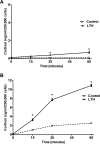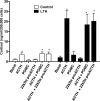Long-term hypoxia enhances cortisol biosynthesis in near-term ovine fetal adrenal cortical cells
- PMID: 21079237
- PMCID: PMC3057304
- DOI: 10.1177/1933719110386242
Long-term hypoxia enhances cortisol biosynthesis in near-term ovine fetal adrenal cortical cells
Abstract
This study was designed to determine the potential mechanism/mechanisms of previously observed enhanced fetal cortisol secretion following exposure to long-term hypoxia (LTH). Pregnant ewes were maintained at high altitude (3820 m) for approximately the last 100 days of gestation. Between the gestation days of 138 and 141, adrenal glands were collected from LTH and age-matched normoxic control fetuses. Cyclic adenosine monophosphate (cAMP), cortisol, and steroidogenic acute regulatory (StAR) protein were measured in response to adrenocorticotropic hormone (ACTH) stimulation. Cortisol responses to ACTH were also measured in the presence of the protein kinase (PKA) inhibitor H-89, proopiomelanocortin (POMC), or 22-kDa pro-ACTH. Cortisol output was higher in the LTH group compared to the control (P < .05), following ACTH treatment while the cAMP response was similar in both groups. Although PKA inhibition decreased cortisol production in both groups, however no differences were observed between groups. Western analysis revealed a significant increase in protein expression for StAR in the LTH group (P < .05, compared to control). Proopiomelanocortin and 22-kDa pro-ACTH did not alter the cortisol response to ACTH treatment. Results from the present study taken together with those of previous in vivo studies suggest that the enhanced cortisol output in the LTH group is not the result of differences in cAMP generation or PKA. We conclude that enhanced cortisol production in LTH adrenals is the result of enhanced protein expression of StAR and potential downstream signaling pathways.
Conflict of interest statement
The authors declared no conflicts of interest with respect to the authorship and/or publication of this article.
Figures





Similar articles
-
Extracellular signal-regulated kinases (ERK1/2) signaling pathway plays a role in cortisol secretion in the long-term hypoxic ovine fetal adrenal near term.Am J Physiol Regul Integr Comp Physiol. 2013 Apr 15;304(8):R636-43. doi: 10.1152/ajpregu.00318.2012. Epub 2013 Feb 20. Am J Physiol Regul Integr Comp Physiol. 2013. PMID: 23427082 Free PMC article.
-
Expression of StAR and Key Genes Regulating Cortisol Biosynthesis in Near Term Ovine Fetal Adrenocortical Cells: Effects of Long-Term Hypoxia.Reprod Sci. 2018 Feb;25(2):230-238. doi: 10.1177/1933719117707056. Epub 2017 May 3. Reprod Sci. 2018. PMID: 28468567 Free PMC article.
-
Adrenocortical and adipose responses to high-altitude-induced, long-term hypoxia in the ovine fetus.J Pregnancy. 2012;2012:681306. doi: 10.1155/2012/681306. Epub 2012 May 14. J Pregnancy. 2012. PMID: 22666594 Free PMC article. Review.
-
Nitric oxide inhibits ACTH-induced cortisol production in near-term, long-term hypoxic ovine fetal adrenocortical cells.Reprod Sci. 2010 Oct;17(10):955-62. doi: 10.1177/1933719110376092. Epub 2010 Aug 16. Reprod Sci. 2010. PMID: 20713972 Free PMC article.
-
Maternal and fetal hypothalamic-pituitary-adrenal axes during pregnancy and postpartum.Ann N Y Acad Sci. 2003 Nov;997:136-49. doi: 10.1196/annals.1290.016. Ann N Y Acad Sci. 2003. PMID: 14644820 Review.
Cited by
-
Preeclampsia link to gestational hypoxia.J Dev Orig Health Dis. 2019 Jun;10(3):322-333. doi: 10.1017/S204017441900014X. Epub 2019 Apr 10. J Dev Orig Health Dis. 2019. PMID: 30968806 Free PMC article. Review.
-
Leptin receptor antagonist treatment ameliorates the effects of long-term maternal hypoxia on adrenal expression of key steroidogenic genes in the ovine fetus.Am J Physiol Regul Integr Comp Physiol. 2013 Mar 15;304(6):R435-42. doi: 10.1152/ajpregu.00377.2012. Epub 2013 Jan 23. Am J Physiol Regul Integr Comp Physiol. 2013. PMID: 23344230 Free PMC article.
-
Extracellular signal-regulated kinases (ERK1/2) signaling pathway plays a role in cortisol secretion in the long-term hypoxic ovine fetal adrenal near term.Am J Physiol Regul Integr Comp Physiol. 2013 Apr 15;304(8):R636-43. doi: 10.1152/ajpregu.00318.2012. Epub 2013 Feb 20. Am J Physiol Regul Integr Comp Physiol. 2013. PMID: 23427082 Free PMC article.
-
Expression of StAR and Key Genes Regulating Cortisol Biosynthesis in Near Term Ovine Fetal Adrenocortical Cells: Effects of Long-Term Hypoxia.Reprod Sci. 2018 Feb;25(2):230-238. doi: 10.1177/1933719117707056. Epub 2017 May 3. Reprod Sci. 2018. PMID: 28468567 Free PMC article.
-
Adrenocortical and adipose responses to high-altitude-induced, long-term hypoxia in the ovine fetus.J Pregnancy. 2012;2012:681306. doi: 10.1155/2012/681306. Epub 2012 May 14. J Pregnancy. 2012. PMID: 22666594 Free PMC article. Review.
References
-
- Liggins GC, Fairclough RJ, Grieves SA, Kendall JZ, Knox BS. The mechanism of initiation of parturition in the ewe. Recent Prog Horm Res. 1973;29:111–159 - PubMed
-
- Meaney MJ, Viau V, Bhatnagar S, et al. Cellular mechanisms underlying the development and expression of individual differences in the hypothalamic-pituitary-adrenal stress response. J Steroid Biochem Mol Biol. 1991;39(2):265–274 - PubMed
-
- Challis JR, Richardson BS, Rurak D, Wlodek ME, Patrick JE. Plasma adrenocorticotropic hormone and cortisol and adrenal blood flow during sustained hypoxemia in fetal sheep. Am J Obstet Gynecol. 1986;155(6):1332–1336 - PubMed
-
- Fletcher AJ, Gardner DS, Edwards CM, Fowden AL, Giussani DA. Development of the ovine fetal cardiovascular defense to hypoxemia towards full term. Am J Physiol Heart Circ Physiol. 2006;291(6):H3023–H3034 - PubMed
-
- Raff H, Wood CE. Effect of age and blood pressure on the heart rate, vasopressin, and renin response to hypoxia in fetal sheep. Am J Physiol. 1992;263(4 pt 2):R880–R884 - PubMed
Publication types
MeSH terms
Substances
Grants and funding
LinkOut - more resources
Full Text Sources
Miscellaneous

